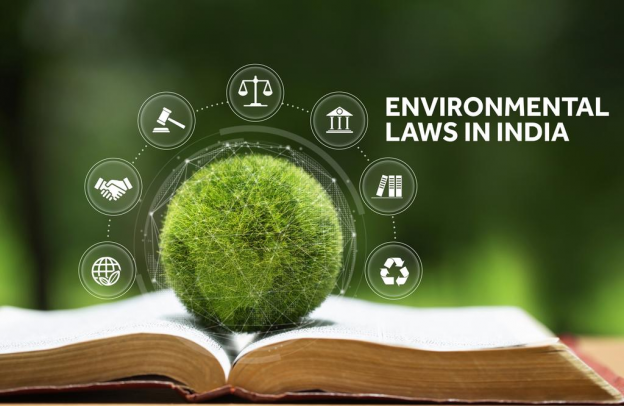
Author: Manshwi Anand, ILS Law College
Introduction
Deterioration of the climate has become a ubiquitous phenomenon worldwide. Today around 75% of the earth’s land surface has been significantly altered by human actions which includes 85% of wetlands.[1] Presently, every domain of life be it political, social and economical is being affected by destruction of the environment. At this juncture, the importance of jurisprudence and legal frameworks to tackle the worsening of the environment becomes critical.
Various nations around the world have taken steps in the direction of strengthening the legal foundation of environmental regulations. Speaking especially about India, we have come a long way as far as environmental protection is concerned.
To understand the various efforts taken by India towards environmental protection, it is essential to be conscious of the integral legislations, institutions as well as international resolutions that India is a part of.
A) CENTRAL STATUTES–
the national laws that are enacted by the Parliament of India.
1. Environmental (Protection) Act 1986– It is a versatile legislation which encompasses a broad framework for tackling environmental issues beyond water and air pollution. It enables the government to quickly respond to environmental emergencies as well as authorize the common population to report complaints against environmental violations.
2. Water (Prevention and Control of Pollution) Act 1974– Mandates industries to follow regulations concerning effluent discharge in water bodies. It additionally talks about conducting regular checks to monitor the quality of water by authorities.
3. Air (Prevention and Control of Pollution) Act 1981– Set emission standards such as the Bharat Stage Emission Standard norms for automobiles as well as put in place emission regulations for industries.
4. Wildlife (Protection) Act 1972– Provides protection to a wide range of wildlife species including mammals, reptiles, birds, amphibians, etc. Put an outright ban on poaching and killing of certain animals. The act further stipulates the establishment of wildlife parks and sanctuaries for the well-being of animals.
5. Forest (Conservation) Act 1950– The act restricts the use of forest land for any industrial purpose without the beforehand approval of the central government. Moreover, it also promotes forest conservation activities to promote forest conservation.
B) INSTITUTIONS–
Numerous institutions have been put in place by various legislations to cater to environmental protection. The Ministry of Environment, Forest and Climate Change is the apex body for the governance of the environment in India. It was first established as the Ministry of Environment and Forests in 1985. However, the priority of the ministry was increased when its name was changed to the present in 2014.
The Central Pollution Control Board (CPCB) is a statutory body under the Ministry of Environment which was established under the Water (Prevention and Control of Pollution) Act 1974 and it draws power from the Air (Prevention and Control of Pollution) Act 1981. The CPCB is the apex body of controlling pollution in India. Additionally, several state pollution control boards have also been established to put directives on the common public, organizations, and industries to check environmental degradation.
The Ministry of Environment, Forest and Climate Change has launched various programs in the recent past to cater to the issue of environmental conservation, namely-
National Clean Air Program (NCAP) – It was launched in the year 2019. With this program, the government aims to reduce air pollution across Indian cities. The major focus lies on monitoring and controlling the amount of air pollution done by industries as well as promoting cleaner fuel and technologies.
Swachh Bharat Mission– An ongoing flagship program of the central government launched in 2014. It aims towards a clean Open Defecation Free (ODF) India with proper sanitation facilities to prevent waste-related pollution.
Circular Economy Action Plan– Involves developing plans for managing waste streams like plastics, e-waste, and end-of-life vehicles by promoting recycling, reuse, and resource recovery.
C) INTERNATIONAL COMMITMENTS–
India for several years now has actively participated in various international environmental agreements and initiatives.
CLIMATE CHANGE
Paris Agreement– The agreement is legally binding in nature. It was adopted by 196 countries at COP 21 in 2015 in Paris. Its major goal is to hold “the increase in the global average temperature to well below 2°C above pre-industrial levels” as well as pursue efforts “to limit the temperature increase to 1.5°C above pre-industrial levels.”[2] India being a signatory of the Agreement has committed to ambitious targets with respect to limiting greenhouse gas emissions by using renewable sources of energy.
International Solar Alliance– The ISA is an alliance of more than 120 member countries with India as a co-founder. All these member nations lie between the Tropic of Cancer and the Tropic of Capricorn. The major objective of the alliance is to promote solar energy deployment to make solar energy more affordable and accessible and reduce dependence on fossil fuels.[3]
2. BIODIVERSITY CONSERVATION
Convention on Biological Diversity[4]– A convention signed by around 150 countries at the 1992 Rio Earth Summit. The paramount goal of the convention is sustainable development to protect the biological diversity on this earth. In support of this convention, India has put forth a National Biodiversity Action Plan that outlines strategies for conserving the rich biodiversity landscape of India.
Convention on Migratory Species[5]– It is a treaty of the United Nations. CMS provides a global platform to conserve migratory species and their habitats. Various countries through which these migratory animals pass are members of CMS. India is a party to this convention as it is integral for protecting India’s diversified migratory bird population and their worldwide cross movements.
3. DESERTIFICATION AND LAND DEGRADATION
The United Nations Convention to Combat Desertification[6]– It is a convention to combat desertification and ease out the effects of drought through national action programs. It was in December 1994 and has since become the only convention focusing on desertification. It is a collective of 197 members, India being one of them.
4. COMBATING POLLUTION
- Montreal Protocol[7]– A Protocol finalized in 1987 in Montreal, Canada, presents itself as an agreement to protect the ozone layer of the stratosphere by phasing out the production and consumption of ozone-depleting substances typically used in refrigerators and air conditioners.
- Stockholm Convention on Persistent Organic Pollutants[8]–The treaty came into force in May 2004. India is a party to the Stockholm Convention which aims to reduce the production of persistent organic pollutants due to their deadly impacts on health and the environment.
India is a fast-paced economy that has arranged for various legal as well as administrative frameworks to address the issue of environmental degradation, many institutions collectively have joined hands towards a significant step in the right direction. However, it is also crucial that these regulations are updated continuously to ensure that they contribute in the making of a sustainable future.
[1] United Nations Environment Programme, Facts about the Nature Crisis, UNEP, https://www.unep.org/facts-about-nature-crisis (last visited May 15, 2024).
[2] United Nations Framework Convention on Climate Change, The Paris Agreement, UNFCCC, https://unfccc.int/process-and-meetings/the-paris-agreement (last visited May 15, 2024).
[3] Wikipedia, International Solar Alliance, https://en.wikipedia.org/wiki/International_Solar_Alliance (last visited May 15, 2024).
[4] Convention on Biological Diversity, https://www.cbd.int/convention (last visited May 15, 2024).
[5] Convention on the Conservation of Migratory Species of Wild Animals, CMS.int, https://www.cms.int/en/legalinstrument/cms (last visited May 15, 2024)
[6] United Nations Convention to Combat Desertification, Wikipedia (last visited May 15, 2024), https://en.wikipedia.org/wiki/United_Nations_Convention_to_Combat_Desertification.
[7]The Montreal Protocol on Substances That Deplete the Ozone Layer, U.S. Department of State, accessed May 15, 2024, https://www.state.gov/key-topics-office-of-environmental-quality-and-transboundary-issues/the-montreal-protocol-on-substances-that-deplete-the-ozone-.
[8] Stockholm Convention on Persistent Organic Pollutants, U.S. Department of State, accessed May 15, 2024, https://www.state.gov/key-topics-office-of-environmental-quality-and-transboundary-issues/stockholm-convention-on-persistent-organic-pollutants/.
The Legal Youngster Other Services:
The Legal Youngster Internship:
https://www.thelegalyoungster.com/legal-internship/












